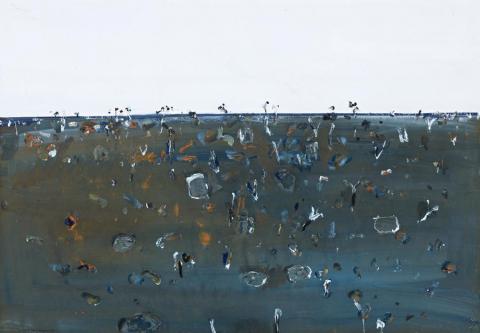UPWEY LANDSCAPE V, 1965
FRED WILLIAMS
gouache on paper
50.5 x 72.5 cm
signed lower left: Fred Williams
Estate of the artist, Melbourne (cat. GW 528, label attached verso)
Lyn Williams collection, Melbourne
Rex Irwin Art Dealer, Sydney
Private collection, Sydney
Fred Williams Landscapes, Rex Irwin Art Dealer, Sydney, 6–31 October 1998, cat. 7 (label attached verso)
Described as a 'conscious, polished, considered statement',1 the Upwey paintings brought Fred Williams considerable public recognition winning him the Georges Invitation Art Prize, the W.D. and H.O. Wills Prize and the Wynne Prize. With the early 1960s occupied by Williams's You Yangs series, Upwey required a re-engaging with the substance and form of paint itself, producing a body of work which acts as the perfect foil to the calligraphic weightlessness of the You Yangs pictures. This dialogue between series, a constant in Williams's work, intensified in the 1960sas he was finally able to work uninterrupted on painting without theburden of disruption. The result was to be one of the most productive and stylistically diverse periods of his career.
The Upwey works were immediately recognised as pictures of substance and importance. The National Gallery of Victoria, Melbourne, acquired examples in 1965 directly from the artist's studio. As observed by Patrick McCaughey 'They were public paintings, with a commanding format that could be read at a distance, and their public success indicates that Williams had found a landscape type that impressed itself immediately upon the viewer as authoritative. The extremes of his art exposed in the Forest paintings, and their opposite in the You Yangs paintings, had given his art its radical, even eccentric quality. Williams now stabilized his vision. Those scattered trees, that scrubby bush of the Upwey landscapes took on a new pictorial dignity and order.'2
Indeed, Williams was so captivated by his work with the Upwey series that it occupied not only the day but also the night. He started to experiment with painting during the full moon, producing such masterpieces as Green cloud and owl paintings. A diary note of 13 February 1965 records his intention to introduce 'a half-tone (Blue) in Background wash'3 to his watercolours in an attempt to capture the shadows cast by moonlight. Dinner guests recalled him leaving the dinner-table during the full moon on 14 February to paint in the dark on the balcony, laughing quietly at his own audacity. Yet without the moonlight we would not have the delicately light-edged voids in this landscape, nor the silver tree trunks bouncing light back to the observant Williams.
1. McCaughey, P., Fred Williams, 1927-1982, Murdoch Books, Sydney, 2008, p. 168
2. Ibid.
3. Mollison, J., A Singular Vision: The Art of Fred Williams, Australian National Gallery, Canberra,1989, p. 91
MERRYN SCHRIEVER
